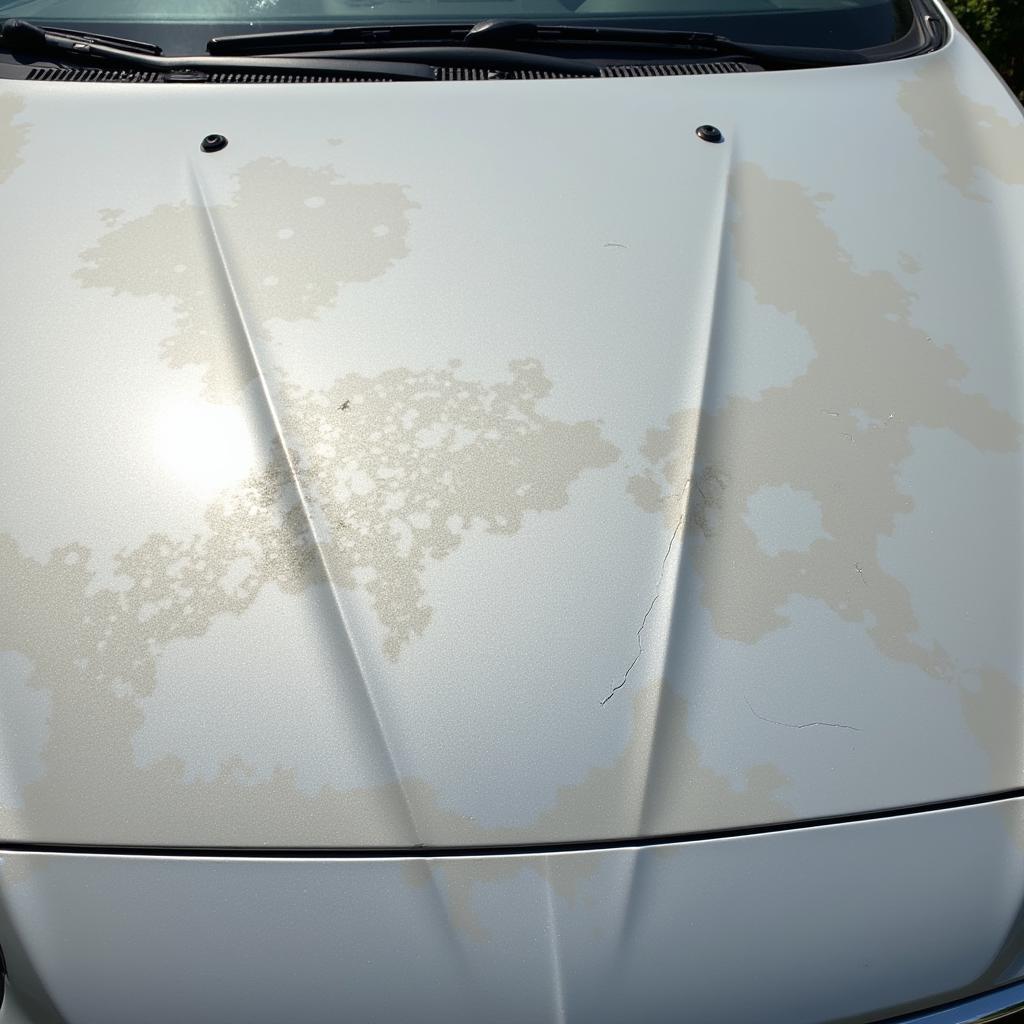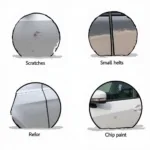Oxidized car paint, often signaled by clear coat failure, can make your vehicle look dull and aged. This guide will cover how to repair oxidized car paint spots and address clear coat failure, returning your car’s finish to its former glory. We’ll explore the causes, the repair process, and preventative measures you can take to protect your car’s paint.
Understanding Oxidized Car Paint and Clear Coat Failure
Clear coat failure and oxidized paint are related but distinct issues. The clear coat is the top layer of your car’s paint, acting as a protective shield against UV rays, acid rain, and other environmental contaminants. When this layer breaks down due to prolonged exposure to these elements, it’s known as clear coat failure. This breakdown can manifest as peeling, cracking, or a hazy, cloudy appearance. Oxidation occurs when the paint underneath the clear coat is exposed to oxygen and begins to deteriorate. This results in a dull, chalky appearance, often with visible discoloration, particularly in darker colored cars. Identifying whether you’re dealing with oxidized paint, clear coat failure, or both is crucial for selecting the right repair method.
 Example of Oxidized Car Paint and Clear Coat Failure
Example of Oxidized Car Paint and Clear Coat Failure
Assessing the Damage: Is it Oxidation or Clear Coat Failure?
Before starting any repairs, determine the extent of the damage. Wash and dry the affected area thoroughly. If the paint feels rough and chalky after washing, you’re likely dealing with oxidation. If you see peeling, cracking, or a cloudy haze, it points towards clear coat failure. Sometimes, both issues coexist. A simple test involves rubbing a small amount of polishing compound on the affected area. If the paint briefly regains its shine, the issue is likely oxidation. If not, the clear coat is probably compromised and requires more extensive repair.
Repairing Oxidized Car Paint Spots
If the damage is primarily oxidation, you can often restore the paint’s shine with a thorough cleaning and polishing. Start by washing the car with a quality car wash soap and drying it completely. Then, apply a rubbing compound to the affected area using a microfiber applicator pad. Work in small sections, applying gentle pressure and circular motions. Once the rubbing compound dries to a haze, buff it off with a clean microfiber cloth. Follow up with a polishing compound and then a sealant or wax to protect the restored paint.
Addressing Clear Coat Failure
Clear coat failure necessitates a more involved approach. Minor clear coat failure can sometimes be addressed with wet sanding and polishing, but significant damage usually requires repainting the affected area. Wet sanding involves using progressively finer grit sandpaper to smooth out the damaged clear coat. This should only be attempted by experienced individuals, as improper technique can damage the underlying paint. Repainting requires careful preparation, including sanding, priming, and applying multiple coats of color and clear coat.
Preventing Oxidation and Clear Coat Failure
Prevention is the best way to protect your car’s paint. Regular washing and waxing are crucial, as wax provides a protective barrier against UV rays and environmental contaminants. Parking your car in a garage or under a car cover whenever possible can minimize exposure to the elements. Avoid parking under trees, as sap and bird droppings can damage the clear coat.
Conclusion
Repairing oxidized car paint spots and clear coat failure can restore your car’s appearance and protect its value. By understanding the causes and choosing the right repair methods, you can maintain your car’s finish for years to come. Remember, regular maintenance is key to preventing future issues and keeping your car looking its best. Addressing these issues early can prevent more extensive damage and costly repairs down the road.
FAQ
- What causes car paint oxidation? Primarily, prolonged exposure to UV rays, acid rain, and environmental pollutants.
- Can I repair clear coat failure myself? Minor issues can sometimes be addressed with wet sanding and polishing, but significant damage often requires professional repainting.
- How often should I wax my car? Every three to six months is generally recommended.
- What is the best way to protect my car’s paint? Regular washing, waxing, and parking in a sheltered area.
- Can oxidized paint be restored? Yes, often with polishing compounds.
- Is it expensive to repair oxidized car paint or clear coat failure? The cost varies depending on the extent of the damage and the chosen repair method.
- How can I prevent bird droppings from damaging my car’s paint? Remove them as soon as possible and consider using a car cover.
Common Scenarios and Questions:
- Scenario: My car’s hood has a dull, chalky appearance. Question: Is this oxidation or clear coat failure?
- Scenario: The clear coat on my car is peeling. Question: Can I just peel off the rest of the clear coat?
- Scenario: I parked under a tree, and now my car’s paint has spots. Question: How do I remove these spots without damaging the paint?
Further Reading and Resources:
Explore our other articles on car maintenance and repair for more helpful tips and advice. You can find more information on specific car care products and techniques on our website.
Contact Us
Need help with your car repair? Contact us via WhatsApp: +1(641)206-8880, Email: [email protected]. Our customer service team is available 24/7.

